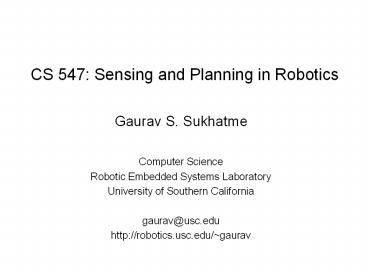CS 547: Sensing and Planning in Robotics PowerPoint PPT Presentation
1 / 27
Title: CS 547: Sensing and Planning in Robotics
1
CS 547 Sensing and Planning in Robotics
- Gaurav S. Sukhatme
- Computer Science
- Robotic Embedded Systems Laboratory
- University of Southern California
- gaurav_at_usc.edu
- http//robotics.usc.edu/gaurav
2
Probabilistic Robotics
- Key idea Explicit representation of uncertainty
using the calculus of probability theory - Perception state estimation
- Action utility optimization
3
Advantages and Pitfalls
- Can accommodate inaccurate models
- Can accommodate imperfect sensors
- Robust in real-world applications
- Best known approach to many hard robotics
problems - Computationally demanding
- False assumptions
- Approximate
4
Axioms of Probability Theory
- Pr(A) denotes probability that proposition A is
true.
5
A Closer Look at Axiom 3
6
Using the Axioms
7
Discrete Random Variables
- X denotes a random variable.
- X can take on a finite number of values in x1,
x2, , xn. - P(Xxi), or P(xi), is the probability that the
random variable X takes on value xi. - P( ) is called probability mass function.
- E.g.
.
8
Continuous Random Variables
- X takes on values in the continuum.
- p(Xx), or p(x), is a probability density
function. - E.g.
p(x)
x
9
Joint and Conditional Probability
- P(Xx and Yy) P(x,y)
- If X and Y are independent then P(x,y) P(x)
P(y) - P(x y) is the probability of x given y P(x
y) P(x,y) / P(y) P(x,y) P(x y) P(y) - If X and Y are independent then P(x y) P(x)
10
Law of Total Probability
Discrete case
Continuous case
11
Reverend Thomas Bayes, FRS (1702-1761)
- Clergyman and mathematician who first used
probability inductively and established a
mathematical basis for probability inference
12
Bayes Formula
13
Normalization
Algorithm
14
Conditioning
- Total probability
- Bayes rule and background knowledge
15
Simple Example of State Estimation
- Suppose a robot obtains measurement z
- What is P(openz)?
16
Causal vs. Diagnostic Reasoning
- P(openz) is diagnostic.
- P(zopen) is causal.
- Often causal knowledge is easier to obtain.
- Bayes rule allows us to use causal knowledge
17
Example
- P(zopen) 0.6 P(z?open) 0.3
- P(open) P(?open) 0.5
- z raises the probability that the door is open.
18
Combining Evidence
- Suppose our robot obtains another observation z2.
- How can we integrate this new information?
- More generally, how can we estimateP(x z1...zn
)?
19
Recursive Bayesian Updating
Markov assumption zn is independent of
z1,...,zn-1 if we know x.
20
Example Second Measurement
- P(z2open) 0.5 P(z2?open) 0.6
- P(openz1)2/3
- z2 lowers the probability that the door is open.
21
Actions
- Often the world is dynamic since
- actions carried out by the robot,
- actions carried out by other agents,
- or just the time passing by
- change the world.
- How can we incorporate such actions?
22
Typical Actions
- The robot turns its wheels to move
- The robot uses its manipulator to grasp an object
- Plants grow over time
- Actions are never carried out with absolute
certainty. - In contrast to measurements, actions generally
increase the uncertainty.
23
Modeling Actions
- To incorporate the outcome of an action u into
the current belief, we use the conditional pdf - P(xu,x)
- This term specifies the pdf that executing u
changes the state from x to x.
24
Example Closing the door
25
State Transitions
- P(xu,x) for u close door
- If the door is open, the action close door
succeeds in 90 of all cases.
26
Integrating the Outcome of Actions
Continuous case Discrete case
27
Example The Resulting Belief

